Understanding Cat Scratches in the Eye: Causes and Treatments
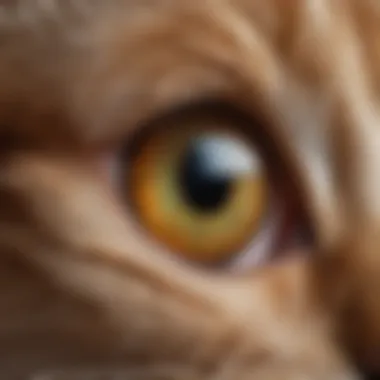

Intro
Navigating life with pets can sometimes lead to unforeseen accidents. One such incident that can cause significant concern is when a cat's claw accidentally makes contact with an eye. The implications of this act are not trifling; a cat scratch on the eye can lead to a range of medical issues, some of which might become serious if not attended to promptly. Cats, by nature, can be quite playful and their claws can be as sharp as knives during both fun and defensively charged moments.
Understanding the underlying causes, immediate effects, and possible treatments for these scratches is crucial—not only for pet owners but also for anyone who comes in contact with these furry companions. This situation reflects not just the need for knowledge around veterinary care but broader awareness about personal health risks related to animals.
Let’s delve deeper into what causes these eye injuries, the biological effects they have, and the treatments available to ensure recovery and long-term eye health.
Article Overview
Summary of Key Findings
Cat scratches in the eye can stem from various activities, ranging from playful engagement to unintentional accidents. The immediate reactions to such an injury may vary widely among individuals and pets, but the need for swift action remains constant.
Notably, the long-term effects can range from mild irritation to more severe conditions such as infections or corneal scarring. Understanding these nuances enhances the management of the injury, alongside immediate first-aid measures. Recognizing the symptoms early on can help in determining whether to seek veterinary help or medical assistance sooner rather than later.
Research Objectives
This article aims to provide a comprehensive guide addressing:
- The common scenarios leading to cat scratches in the eye.
- The physiological impact of scratches on eye health.
- Step-by-step first-aid procedures following an incident.
- Treatment options based on the injury's severity.
- Insights from both veterinary and ophthalmological perspectives to guide readers through managing this condition.
The objective is simple yet significant: equip pet owners and enthusiasts with the necessary knowledge and skills to handle such potentially alarming situations effectively.
Key Results and Discussions
Main Findings
Scratches to the eye from cats can be misleadingly benign at first glance. Certain signs, like minor redness or drainage, may not seem severe. However, one should not underestimate the possibility of deeper damage, as the eye consists of delicate structures that can be easily compromised.
In many cases, the protective layer of the eye, known as the cornea, can endure scratches. Yet, when it gets infringed upon, it could lead to corneal ulcers or even perforations.
According to studies, around 50% of cat-related eye injuries that are left untreated escalate, resulting in chronic pain or vision loss. This statistic sheds light on the importance of being proactive in eye care.
Implications of Findings
The implications extend beyond just immediate first aid; they encompass long-term vigilant care. Learning how to prevent future incidents also holds relevance, especially for those with active cats. For instance, minimizing rough play, regular nail trimming, and providing proper toys can greatly reduce scratching incidents.
Moreover, understanding the signs of possible complications post-injury ensures quicker medical intervention. Remember, a well-informed pet owner can not only safeguard their pet's health but also their own well-being.
Prelude to Eye Injuries
Understanding eye injuries is crucial as it pertains to our daily interactions, especially for those who share their lives with pets like cats. Cat scratches can lead to a range of eye injuries from mild irritations to serious complications that threaten vision. Ignoring signs of injury can lead to lasting damage, affecting both physical health and quality of life. Therefore, awareness of eye injuries highlights the necessity of proper care when faced with a pet-related scratch.
It's not uncommon to think of the eye as resilient; we often take for granted that it can withstand everyday jolts. However, when it comes to feline claws, even a small scratch may not be as trivial as one might assume. The anatomical structure of the eye is delicate, meaning that interventions can be pivotal. Recognizing the significance of eye injuries ensures individuals are prepared to act swiftly and effectively, ultimately minimizing risks.
In the ensuing sections, we will discuss the types of common eye injuries, their implications, and the importance of prompt medical attention. Eye injuries like those from cat scratches may appear harmless at first glance, but they can escalate rapidly. Having a thorough understanding can make all the difference in outcomes.
Overview of Common Eye Injuries
Eye injuries are more frequent than one might think and can stem from various sources like household accidents, outdoors activities, and, notably, pets. Among pet owners, cat-related injuries stand as a leading cause of concern. Common eye injuries include:
- Corneal abrasions: Scratches or scrapes on the eye's surface, often resulting from direct contact.
- Conjunctival lacerations: Tears in the conjunctiva, which can lead to tearing, redness, and potentially infection.
- Foreign bodies: Particles lodged in the eye can cause irritation and damage.
- Chemical burns: Caused by exposure to irritants like household cleaners.
Cat scratches particularly fit into the first two categories. Their sharp claws can inflict significant harm in a mere moment, often during playful or aggressive behavior, underscoring the need for vigilance.
Significance of Prompt Attention
When it comes to eye injuries, the adage "an ounce of prevention is worth a pound of cure" rings especially true. Quick and appropriate action can prevent an injury from developing into something much more serious. If you experience a scratch, observing symptoms such as blurred vision, excessive tearing, or pain should prompt immediate attention.
Ignoring early signs can invite complications, including:
- Infections: Bacterial contamination can evolve into serious conditions like endophthalmitis.
- Vision loss: Prolonged neglect can damage critical components of the eye.
- Chronic pain or discomfort: This may arise from untreated abrasions, affecting daily life.
In instances of minor scratches, first-aid measures may be sufficient. However, if there are any indicators of a severe injury, seeking professional care should be the first course of action. Acting promptly can make all the difference; after all, the eyes are often regarded as the windows to the soul. Treat them with care.
Understanding Cat Behavior
When diving into the topic of eye injuries caused by cat scratches, understanding cat behavior becomes crucial. Cats, with their intricate and sometimes enigmatic ways, have natural instincts that drive them to scratch. Recognizing these behaviors allows pet owners and enthusiasts not only to prevent potential scratches but also to foster better interactions. This deeper grasp of feline behavior, ultimately, aids in reducing the risk of eye injuries for both humans and cats alike.
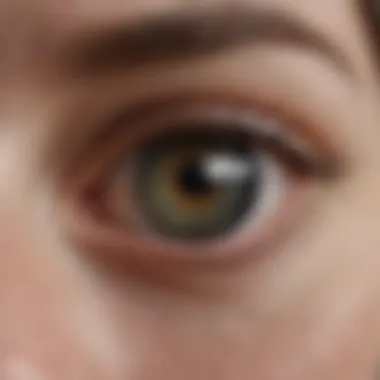
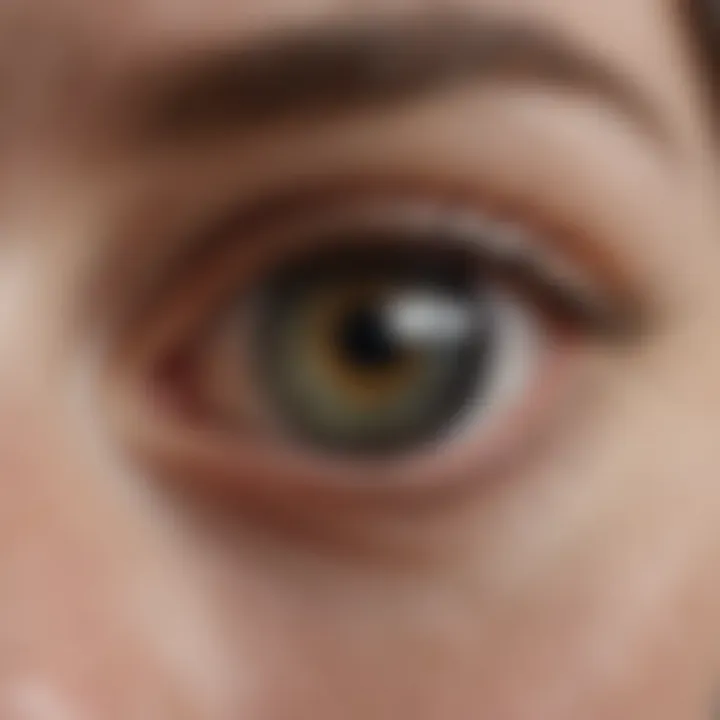
Why Cats Scratch
Cats scratch for a variety of reasons, and these motivations can be as multifaceted as the creatures themselves. Firstly, scratching is a natural instinct. It helps them maintain their claws by removing the old, dead outer sheath, keeping them sharp and healthy. Beyond mere claw maintenance, scratching serves as a means of marking territory. Cats have scent glands in their paws, and scratching can leave their unique smell on objects, signaling to other felines that this space is theirs.
Moreover, scratching plays a critical role in stretching their muscles and keeping them physically active. A well-scratched cat is often a happy cat, content in the knowledge that its instincts are being fulfilled. Understanding that these actions are deeply rooted in their nature helps in finding effective strategies to mitigate the risk of scratches.
A scratching cat often signals a fulfilled need, not an attack.
Impacts of Play and Aggression
Playtime is another essential aspect of a cat’s life, but it can sometimes lead to unintended consequences. When cats engage in play, their instincts come alive. They pounce, swat, and, ultimately, may scratch. Understanding the line between playful behavior and aggression is imperative. In playful moments, a cat might exhibit behaviors that mimic hunting, leading to swipes that could cause injury.
On the other hand, there are scenarios where aggression takes charge. This can be influenced by stress factors such as changes in the environment or territorial disputes. An aggressive swipe from a cat can result in a scratch that may not only be painful but can also endanger one’s eye health.
Key takeaways include:
- Cats scratch as a natural behavior, essential for claw maintenance, territory marking, and exercise.
- Understanding the playful versus aggressive scratching can help in prevention strategies.
- Awareness of stressors that may induce aggression is crucial in managing cat interactions.
Mechanisms of Eye Injury
Understanding the mechanisms of eye injury is crucial for grasping how cat scratches can lead to significant complications. Eye injuries from scratches are not just a matter of minor discomfort; they can evolve into serious conditions that necessitate prompt intervention. This section covers how cat claws can cause injuries to the eye and delineates the types of eye injuries that can result, providing a comprehensive understanding of the implications for eye health.
How Cat Claws Can Inflict Damage
Cat claws are far more than just basic tools for climbing; they are sharp and can inflict serious harm. When a cat swats at a human, which often seems playful, their claws can inadvertently cause painful scratches. These scratches can disrupt the delicate structure of the eye, particularly the cornea and conjunctiva. In such scenarios, the sharpness of cat claws can lead to corneal abrasions or conjunctival lacerations, which require immediate attention.
Moreover, during playful wrestling or roughhousing, a cat might scratch while playing, leading to accidental yet severe injuries. This highlights the need for cat owners to be mindful of their interactions with their pets and to understand the potential for unexpected incidents.
Types of Eye Injuries Caused by Scratches
Corneal Abrasion
Corneal abrasion is one of the most common types of eye injury resulting from cat scratches. It occurs when the surface of the cornea, which is the clear front part of the eye, gets scratched. The primary aspect of corneal abrasion is its ability to cause intense pain and discomfort, making it a significant concern in eye care.
One key characteristic of corneal abrasion is that it often leads to symptoms like tearing, redness, and sensitivity to light. It's a popular focus here because it illustrates how a seemingly minor scratch can lead to major discomfort and potential complications. If left untreated, a corneal abrasion can progress to more serious conditions such as corneal infections or scarring.
A unique feature of corneal abrasion is that its recovery can vary significantly. While some abrasions may heal within a couple of days, others could take much longer, depending on the scratch's severity and the individual's overall eye health. Thus, treating corneal abrasions promptly minimizes risks and supports a smoother healing process.
Conjunctival Laceration
Another injury that can result from a cat scratch is a conjunctival laceration. This type of injury involves a tear in the conjunctiva, a thin membrane covering the white part of the eye and the inside of the eyelids. The immediate consequence of a conjunctival laceration is increased risk of infection and discomfort that can lead to more severe complications if not addressed properly.
The defining characteristic of conjunctival laceration is its potential for excessive bleeding and inflammation, often making it a concerning topic for this discussion. When a cat's claw breaches this membrane, it can lead to significant pain and discomfort, underscoring the need for careful monitoring. This makes conjunctival laceration a critical point of consideration for anyone looking to understand the broader implications of cat scratches in the eye.
The unique feature of conjuctive laceration lies in its management. While some minor lacerations may heal on their own, significant tears could require surgical intervention. Hence, recognizing the symptoms early can make a notable difference in treatment outcomes, emphasizing the need for vigilance after any eye injury – a recurring theme in maintaining eye health.
Immediate Response to a Cat Scratch
When it comes to handling a cat scratch to the eye, immediate response can be the difference between a minor inconvenience and a serious medical issue. Understanding why and how to react quickly is crucial. Eye injuries, especially those from pets, often escalate if not treated promptly. Therefore, knowing the first steps is essential for maintaining optimal eye health.
Injuries can happen in the blink of an eye—literally. One moment you're playing with your cat, and the next, a playful swat can lead to a scratch. The risks associated with such incidents are significant. It is often said that an ounce of prevention is worth a pound of cure. In this case, being prepared with the right knowledge is part of the equation.
First Aid Techniques
Applying the correct first aid procedures right after a scratch can significantly reduce potential harm. Here's a breakdown of steps to take:
- Rinse the Eye: Gently flush the eye with clean water or saline solution. This helps remove any foreign particles that may have entered with the scratch.
- Don’t Rub: The irritation may tempt you to rub your eye, but this could worsen the damage.
- Avoid Over-the-Counter Drops: Don’t use any medicated drops without professional advice, as they can complicate the situation.
These immediate steps can help stabilize the condition. As is often said, sticking to the plan is crucial when confronting adversity.
When to Seek Medical Attention
While first aid can alleviate minor issues, certain signs should alert you to seek medical help without delay:
- Persistent Pain or Discomfort: If the pain does not lessen, it might indicate a deeper injury.
- Redness or Swelling: These could be signs of infection or significant irritation.
- Vision Changes: If you notice blurriness, halos, or any alterations in sight, don’t brush it off.
- Tears or Fluid Discharge: Unusual discharge could signal an infection; becoming cautious is wise.
"Ignoring early signs is like leaving a small crack in a dam; it may lead to a larger catastrophe if not addressed swiftly."
It's wise to consult an ophthalmologist or an emergency room when these signs manifest. Sometimes, the best course of action is to err on the side of caution.
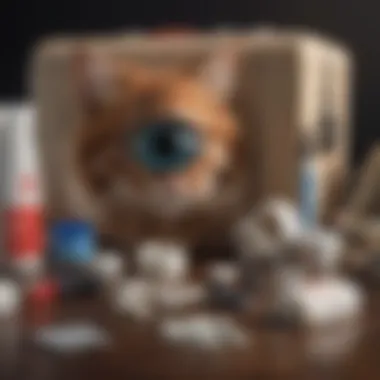

Clinical Assessment of Eye Injuries
Assessing an eye injury properly is critical to ensuring the best possible outcome. This section focuses on the clinical evaluation that follows an injury from a cat scratch, emphasizing what practitioners and affected individuals should look for. A diligent assessment can make a substantial difference in treatment options and healing process.
Signs and Symptoms to Monitor
When it comes to cat scratches around the eye, a few key signs can serve as red flags. It's essential to keep an eye out for:
- Redness and Swelling: Unusual swelling around the eye area often indicates inflammation or an allergic reaction.
- Tearing or Discharge: Excessive watering or pus might suggest an infection or severe irritation.
- Sensitivity to Light: If the affected person squints often or shows discomfort towards bright lights, this could mean something serious.
- Pain or Discomfort: Noticeable or increasing pain should never be ignored; the intensity often gives clues about the injury's severity.
Each of these symptoms demands attention. Anyone experiencing such outcomes after an interaction with a cat should consult a professional.
Diagnostic Tools and Techniques
Two primary tools stand out for professionals assessing eye injuries: the slit-lamp examination and fluorescein staining.
Slit-Lamp Examination
The slit-lamp examination is a cornerstone in eye health diagnostics. This technique allows healthcare providers to effectively view the front structures of the eye, including the cornea, lens, and anterior chamber.
Key Characteristics Unmatched Magnification: The slit-lamp provides remarkable detail thanks to its magnification capabilities. This allows practitioners to see the minutiae of any scratches or abrasions that could result from a feline's claws.
Advantages: It's a highly beneficial choice for diagnosing various eye problems. Through this examination, detailed assessments can inform treatment.
Unique Features: One unique feature of a slit-lamp is its ability to shine light at different angles, which aids in detecting disturbances in the eye’s surface. This aids not just in pinpointing the injury but also in determining its severity.
Fluorescein Staining
Fluorescein staining serves as a critical diagnostic technique for identifying corneal injuries. This process uses a fluorescent dye to assess the eye's surface.
Key Characteristic Visual Identification: The bright green color of the dye highlights specific areas and reveals any scratches present.
Advantages: By clearly marking the injury, healthcare providers can easily locate damage and ascertain its depth and extent. It provides a straightforward yet informative visual cue during assessment.
Unique Feature: One unique feature of fluorescein staining is its ability to delineate the difference between superficial scratches and deeper erosions that may require further treatment, such as surgical intervention. This distinction is essential for tailoring the most appropriate care for the patient.
"Timely and accurate evaluations can prevent long-term complications, transforming the prognosis of what seems like a minor injury."
Each of these tools plays an indispensable role in guiding treatment and ultimately helps forge a path towards recovery after cat scratch injuries. By understanding the tools and signs, individuals involved can take informed steps toward managing their eye health.
Potential Complications from Cat Scratches
When one thinks about the charming nature of a cat, the idea of a sudden scratch on the eye may not be at the forefront of the mind. However, understanding the potential complications that arise from such injuries is critical. A cat scratch, particularly one that impacts the delicate structures of the eye, can lead to various problems, affecting both immediate and long-term health.
Infection Risks
After a cat scratch, one of the primary concerns is the potential for infection. The bacteria present in the cat's claws and fur can swiftly enter the wound. If the scratch penetrates the eye, it becomes a pathway for these microorganisms.
Some common infections to be vigilant about include:
- Bacterial conjunctivitis: This affects the conjunctiva and can lead to redness, swelling, and discomfort in the eye.
- Corneal ulcer: If the tear in the eye doesn't heal properly, it may develop into a deeper ulcer that can result in severe pain.
- Endophthalmitis: A rare but serious condition where an infection spreads inside the eye, leading to vision loss.
A prompt assessment by a medical professional is critical to avoid these complications. Signs of infection often include increasing redness, discharge, or heightened sensitivity to light. Keeping an eye on these symptoms is essential.
Long-term Consequences
Cat scratches might seem trivial at first blush, but overlooking them can lead to lingering effects that create ongoing issues. Besides infections, other complications could emerge over time:
- Scarring: If the scratch damages the cornea significantly, it may leave a scar that can affect vision clarity.
- Chronic inflammation: In some cases, the eye can maintain a state of inflammation long after the initial injury, leading to discomfort and potential loss of vision.
- Vision impairment: Depending on the severity and location of the scratch, not addressing it timely could potentially result in loss of visual acuity or even blindness.
- Psychological impacts: For those who love their pets, a lingering injury can affect how they interact and play with them, possibly leading to feelings of guilt or anxiety about future scratches.
"An ounce of prevention is worth a pound of cure." This idiom underscores the necessity of understanding potential complications following a cat scratch. By staying informed and exercising caution, one can keep these long-term consequences at bay, promoting better outcomes for eye health.
Treatment Strategies for Eye Scratches
When a cat scratch occurs, particularly one that affects the eye, driving home the significance of proper treatment strategies is paramount. Eye injuries can lead to complications that may not be immediately visible but could escalate if left unchecked. An appropriate response can aid in preventing infections and in maintaining vision clarity. Understanding treatment strategies encompasses not just immediate care, but also long-term management and preventive measures to safeguard eye health.
Antibiotic Use and Preventive Measures
Proper usage of antibiotics plays a crucial role in managing infections that may develop from cat scratches. If a scratch penetrates any deeper than the surface, it exposes the eye to a whole host of bacteria that can result in conjunctivitis or worse. Here are some considerations regarding antibiotic use:
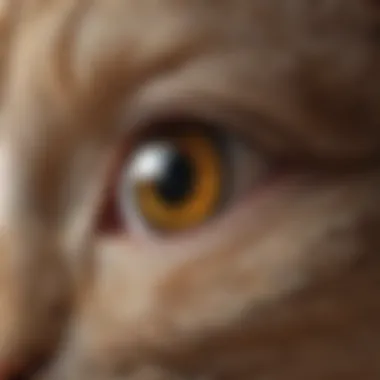
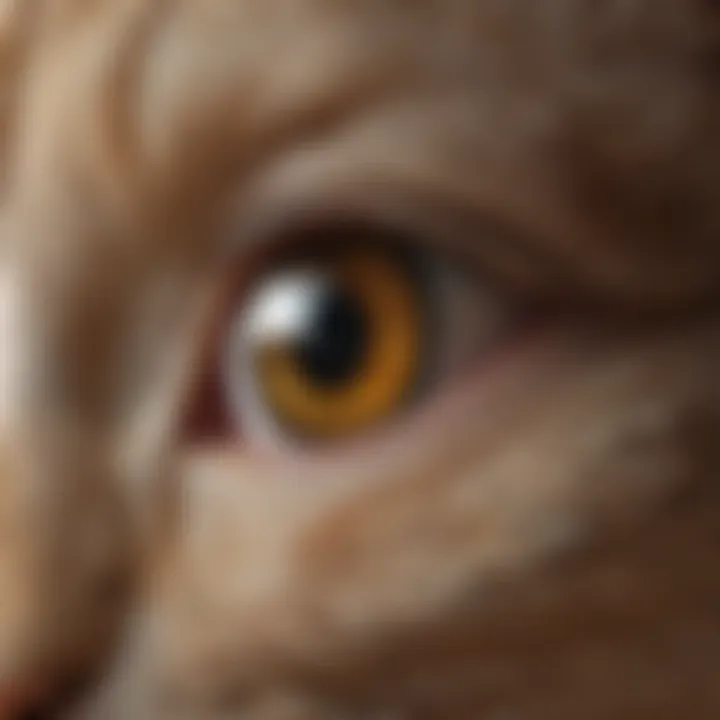
- Assessing Severity: The severity of the injury will largely dictate whether antibiotics are necessary. In minor cases, topical antibiotics may suffice, while more serious injuries might require oral antibiotics.
- Doctor's Recommendation: Always consult a healthcare professional before starting any antibiotic regimen. Self-medicating can often lead to inappropriate treatments and potential resistance.
- Topical Treatments: Common topical antibiotics like Tobramycin and Ciprofloxacin can be effective against surface-level conjunctival infections.
- Preventive Measures: A big part of preventing eye injuries involves understanding and managing interactions with cats. Always be cautious and teach children how to play kindly with pets to minimize aggressive scratching.
Here are some preventive measures to be aware of:
- Keep nail trimming a part of your routine when it comes to cat ownership. Keeping claws short can significantly reduce the risk of accidental scratches.
- Establish a safe space for your cat where they can retreat and feel secure, rather than becoming defensive in threatening situations.
“An ounce of prevention is worth a pound of cure.” This old saying holds especially true for ensuring the safety of both your cat and your vision.
Follow-up Care and Monitoring
Follow-up care is essential in ensuring that the scratch does not lead to further complications. Monitoring the eye after an injury can be the difference between a quick recovery and a more severe condition. Here’s what to keep in mind during follow-up care:
- Regular Checks: Keep an eye on any changes in your pet’s behavior or the affected eye. Any signs of increased redness, swelling, or discharge signal an immediate need to contact a veterinarian.
- Scheduled Appointments: Depending on the initial diagnosis, follow-up appointments with an eye care specialist may be necessary, particularly if surgery is warranted or if there's ongoing eyelid or cornea involvement.
- Note Changes: Take note of any changes in visual capabilities. If your cat appears to be squinting more or rubbing the eye excessively, it could indicate discomfort or ongoing irritation.
- Medication Adherence: Ensure that any prescribed medications are administered as directed. Stopping a course of antibiotics prematurely can lead to properties, and reinfection.
A cohesive strategy for dealing with eye scratches, incorporating both antibiotics and continued care, forms a robust plan for recovery and prevention. Keeping a keen eye—not too punny—on the health of your pet’s eyes is one small habit that ensures larger benefits down the line.
The Role of Veterinary Advice
Veterinary advice plays a critical role in understanding and managing cat scratches in the eye. While many people may think they can handle minor injuries with home remedies or over-the-counter treatments, seeking professional guidance is paramount. Veterinarians possess specialized knowledge and training, allowing them to assess the injury accurately and recommend an appropriate course of action. Moreover, they can identify potential complications that might arise from a cat scratch, which can include infections or more severe damage to the eye.
This section delves into the reasons why consulting with veterinarians is essential not only for immediate relief but also for long-term eye health. Understanding the risks that accompany cat scratches promotes the necessity of professional evaluation to ensure that the correct treatment is employed right away.
Consulting with Veterinarians
When a person is scratched in the eye, it is essential not to delay seeking veterinary advice. This is especially true for cat owners, as cat scratches can lead to several complications, which can have lasting effects on eye health. A veterinarian will perform a thorough examination, checking for signs of damage, including any corneal abrasions or scratches that may not be seen with the naked eye.
- Assessing Severity: The veterinarian will determine how serious the injury is and whether immediate intervention is necessary.
- Tailored Treatment Plans: Based on the findings, a personalized treatment plan can be developed. This may include antibiotics to prevent infection or specific ocular drops to help with healing.
- Monitoring Progress: Regular follow-ups may be recommended to assess recovery and adjust treatment plans as needed.
In some cases, a veterinarian might refer the patient to a veterinary ophthalmologist, who specializes in eye diseases and injuries in animals. This ensures the best possible outcome for the injured eye, involving more sophisticated diagnostic tools that regular veterinary clinics may not have.
Understanding Cat Health and Behavior
A comprehensive understanding of cat health and behavior equips pet owners with tools to minimize the risk of injuries. Many cat scratches arise from play behaviors or misunderstanding between the owner and the cat.
- Feline Body Language: Knowing when a cat is comfortable or agitated can help prevent scratches before they happen. Signs of agitation may include flicking tails or pinned ears, which precede defensive actions.
- Encouraging Appropriate Play: Utilizing toys that keep a safe distance between hand and paw can prevent direct contact. Instead of using hands, use laser pointers or feathers on sticks to engage with your cat. This helps satisfy their hunting instincts while keeping both the cat and owner safe.
- Creating a Low-Stress Environment: Providing a comfortable setting allows cats to express their natural behavior without feeling threatened. Stress can often lead to aggression, so maintaining a peaceful home enhances overall cat wellbeing.
Key Takeaway: By understanding cat behavior and health, owners can play an active role in preventing future eye injuries and ensure a safer environment for both themselves and their pets.
Preventive Measures to Avoid Scratches
When it comes to navigating the world of our feline friends, understanding preventive measures to avoid scratches is paramount. Cat scratches can lead to serious eye injuries, and recognizing how to minimize this risk is vital for every cat owner. With a proactive approach, you can protect your eyes and maintain a harmonious relationship with your furry companions.
Proper Interaction with Cats
Interaction with cats should be guided by an awareness of their body language. Cats have their unique way of expressing themselves. For instance, when a cat flicks its tail or flattens its ears, it could be signaling discomfort or irritation.
- Respect their space: Always approach a cat slowly, allowing them to sniff and acclimate to your presence. Ignoring their need for personal space can lead to defensive behaviors like scratching.
- Avoid overstimulation: Many cats enjoy being petted, but too much can provoke them. Pay close attention to their reactions. If a cat suddenly shifts from relaxed to tense, it’s time to back off.
- Use toys for interaction: Engaging your cat with toys like feathers or laser pointers helps redirect their natural instincts away from your hands. This not only stimulates them but also keeps your hands and face safe from swift claw strikes.
Building a bond with a cat requires patience and understanding their social cues. Developing this mutual respect is essential to ensuring safe interactions that minimize scratch risks.
Creating a Safe Environment
A well-structured environment can make a world of difference in preventing cat scratches. It’s about creating a setting where both you and your cat feel comfortable and secure.
- Establish safe zones: Designate areas in your home where your cat can retreat when they feel overwhelmed. Providing cozy spaces enhances their sense of security, reducing the chances of them lashing out in fear.
- Remove potential irritants: Identify and eliminate objects or elements that may stress your cat. Loud noises, sudden movements, or the presence of unfamiliar pets can be a source of anxiety.
- Educate others in the household: If you have kids or frequent guests, teach them how to interact with the cat properly. Clear communication about handling the cat can go a long way in minimizing risks.
- Keep nails trimmed: Regularly trimming your cat's nails reduces the potential for damage during playful encounters. It also gives you a bit more confidence when you're engaging with them.
By being thoughtful about your cat’s environment and how you interact with them, you greatly decrease the likelihood of eye injuries caused by scratches. Just being mindful can save you a lot of hassle down the road.
Culmination
The conclusion of this article brings together several key themes highlighted throughout the discussion on cat scratches in the eye. It’s crucial to grasp the myriad causes that lead to such injuries, whether it's a playful swipe from a cat or an unexpected moment of aggression. Recognizing these circumstances allows pet owners and caregivers to stay vigilant and prevent accidents before they occur.
While every situation is different, knowing immediate response measures makes a significant difference in outcomes. The right first aid can minimize harm and prevent infections, which is paramount considering potential complications resulting from untreated scratches.
Summarizing Key Points
- Awareness of Behavior: Understanding how cats scratch and the motivations behind their actions helps in anticipating interactions and reducing risks.
- Preventive Measures: Creating a safe space for both humans and cats can significantly reduce the likelihood of eye injuries. This involves adjusting play techniques and providing safe toys.
- Importance of Immediate Response: Knowing how to treat an eye injury promptly drastically alters the healing process. This can mean the difference between a simple scratch and a severe long-term injury.
- Veterinary Input: Collaborating with veterinary professionals ensures that both cats and humans are properly safeguarded against potential complications from eye injuries.
- Informed Decisions: Being educated about treatments and their implications empowers individuals to make choices that foster eye health and overall well-being.
Encouraging Awareness and Care
Encouraging awareness about cat scratches is not only about understanding risks; it is also about fostering a deeper connection with your pet. By being proactive in managing their behaviors and creating a conducive environment for safe interactions, you can enhance your relationship with your feline friend.
Education plays a pivotal role here. Owners should inform themselves continuously about cat behavior, eye care, and potential health issues that may arise from scratches. Joining communities, whether through social media platforms like Facebook or dedicated forums on Reddit, can offer support and tips from other cat owners.
Additionally, routine check-ups can catch issues before they escalate. By embracing a preventive mindset and treating your cat with compassion and understanding, the harmony between human and feline can flourish, reducing the chances of injury while enhancing mutual respect and love.
Understanding the way cats interact with their environment is crucial. The more informed we are, the better we can protect ourselves and our beloved pets.







